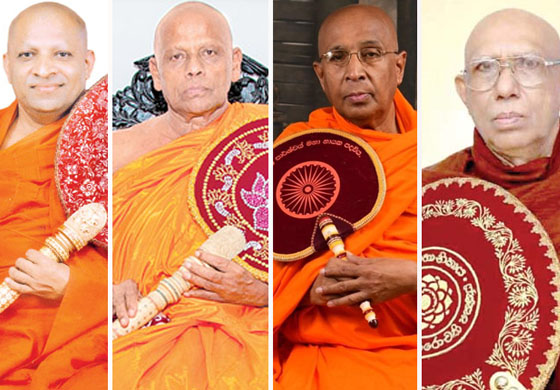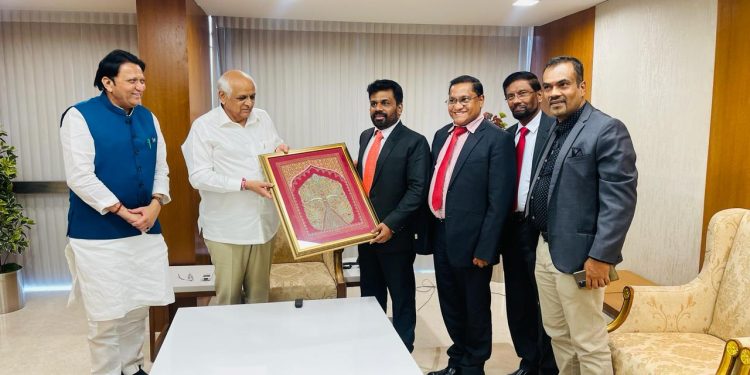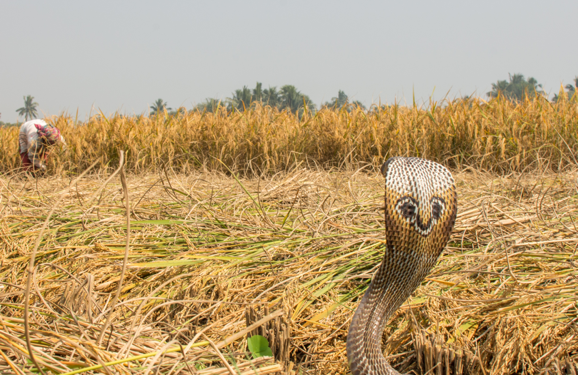මධ්යම කඳුකරයේ දැනට සිදු කරණ පරිසර විනාශය සහ ඉන්දියාවට පාවාදීම වහාම නතර නොකලොත්………?
March 5th, 2024දේශමාන්ය ආචාර්ය සුදත් ගුණසේකර
මධ්යම කඳුකරයේ දැනට සිදු කරණ පරිසර විනාශය සහ ඉන්දියාවට පාවාදීම වහාම නතර නොකලොත්, වසර 25ක් තුල සින්හල ජාතිය, වසර 2566 රැකගත් මේ රට ඔවුන්ට අහිමිවනු ඒකාන්තය.එසේම තවත් වසර 100 කින් සින්හල ජාතියද මේ මිහි පිටින්ම අතුරුදන් වනු ඇත.
මේ රටේ සියළුම දේශපාලනපක්ෂ ඉන්දියාව සමඟ එකතුවී මධ්යම කඳුකරයේ දැනට සිදු කරණ පරිසර විනාශය සහ ඉන්දියාණු කරණය වහාම නතර නොකලොත්, වසර 25ක් තුල වසර 2566 තිස්සේ, ඉන්දියාව saha බටහිර සතුරන්ගෙන් ජීවිත පරිත්යාගයෙන් රැකගත්, මේ රට වසර 25 ක් තුල සින්හල ජාතියට අහිමිවනු ඒකාන්තය.එසේම ඊට අමතරව වසර 100 ක් තුල සින්හලද ජාතිය මේ මිහි පිටින් අතුරුදන් වනු නියතය.
(මෙම ලිපිය ලියන්නේ 1815 මාර් 2 වන දින උඩරට
ගිවිසුමෙන් සුද්දන්ට මේ රට පාවාදුන් දිනය නිමිත්තෙනි))
ශ්රී ලන්කාවේ මධ්යම කඳුකරය යනු මේ රටේ සහ සින්හල ජාතියේ භූගෝලීය මෙන්ම අයිතිහාසික හදබිමද”වේ. මන්ද ඉතිහාශය පුරාම එහි ස්වාභාවික පවැත්ම මෙන්ම ශිෂ්ඨාචාරයේ පැවැත්ම කෙරෙහිද එතරම්ම තීරනාත්මකව එය බලපා ඇති නිසාය.
එසේම පළමුව එහි ස්වරූපය මෙන්ම දෙවණුව ක්රියාකාරිත්වය අනුව එය හදවතකට සමකළ හැකි බැවිනි. පහත සඳහන් රූපසටහන බලන්න.

රුධිර සන්සරණ ක්රියාවලියේදී, පිලිවෙලින් ශිරා හරහා අපිරිසිදු ලේ පිටකිරීම සහ ධමනි හරහා පිරිසිදු ලේ හදවතකරා ගෙන එන්නා සේම මධ්යම කඳුරටේද එහි ආරම්භවන ගන්ගා දිගේ අපිරිසිදු ජලය මුහුදට ගලාගෙනගොස් සන්වහන ක්රියාවලිය තුලින් නැවතත් වර්ෂාව වෂයෙන් කඳු රටට පැමිණෙයි. හදවතේ ක්රියා කාරිත්වය නතරවු දාට සත්වයා මිය යන්නා සේම මධ්යම කඳුකරයේ භෞතික ස්තාවරත්වය නැතිවූදාට එහි ස්වාභාවික ක්රියාකාරිත්වයද නතරවි ශ්රී ලන්කාව නමැති ජීවියාද මියයනු ඒකාන්තය. එහි භෞතික ස්ථාවරත්වය ආරක්ෂා වනුයේ මධ්යම කඳු කරයේ වනාන්තර, භූමිය සහ පසේ ආරක්ෂාව සහ නොකඩවා ජල සැපයුම යන සාධක මතය.
මධ්යම කඳු කරය අපේ රටේ හදවත”වන්නේ මේ අනුවය. එහි සුවිශේෂී භුවිෂමතාව සහ අක්ෂාන්ශක පිහීටිම සහ මු. ම. 2,524 මී (අ 8281) අඩී දක්වා ඉහලට නැගීම සහ භූ විෂමතාව නිසා මේ රටේ මධ්යම කඳුකරය ප්රධාන වර්ෂාකාරකයක් වෙයි. ඉන් ආරම්භවන ගන්ගා 103 අට දිසාවටම ගලායමින් මුළු ලක් දෙරනේම ගහකොල සතා සිව්පාවා සහ මිනිසා ඇතුලු සමස්ත ජීවී පද්ධතියටම ජීවය ලබා දෙයි. එයින් මුළු දිවයිහිනේම ශිෂ්ඨාචාරයද රැකෙයි. වනාන්තරය නිසා භුමියේ සෝදාපාලුව රැකෙන අතර වනාන්තරය අධාරයෙන් භූගතවන ජලයයෙන් රටේ ඇති විශාලතම භූගත ජලාශයද නිර්මාණය වී ඇත. ඉන් නැගෙන උල්පත් වලින් ගන්ගා 103 ටම වසර පුරාම නොකඩවා දියවර ලබා දෙයි. ගහකොලින් භූමියට ලැබෙණ ආවරණය නිසා පස සෝදායාම වැලකී වසර පුරා ඇති සමස්ථ ජීවී පද්ධතියටම ජලය ලබාදෙයි. ඒ අනුව රටේ සමස්ථ ජීවී පද්ධතිය සහ ශිෂ්ඨාචාරයද රැකෙයි.හදවතේ ක්රියාකාරිත්වය නතරවූදාට ජීවියා මියයන්නා සේම කඳුරටින් ගලාබස්නා ගන්ගා නතරවූදාට ලන්කාව නමැති ජීවියාද මියයනු ඒකාන්තය.එමනිසා මධ්යම කඳුකරයේ භෞතික ස්ථාවරත්වය ආරක්ෂාකිරීම සකළ ලන්කාවාසි සියළු දෙනාගේම පරම යුතුකමකි. එය ඔවුන්ගේ හදවත මෙන් ආරක්ෂාකොට ගත යුතුය.
මේ රටේ පුරාණ රජදරුවන් මේ බව හොඳින් දැන සිටියා. ඉතිහාසය පුරා මූ.ම. අඩි 3500 ට ඉහල මුළු කඳුකරයම රාජ ආඥාවලින් තහන්චි කැලයක් වෂයෙන් ආරක්ෂාකළේ ඒ නිසාය. එම ආරක්ෂාව ව්නාශකිරීම ආරම්භ වූයේ 1815 දී බ්රතාන්යයන්ගේ පැමිනීම සමඟය.
රටේ භූගෝලීය හදබිම-(මධ්යම කඳුකරය තුල අඩි 1000 සිට 8500 දක්වා) අතිෂයින්ම සන්වේදී කඳු මුදුන් සහ බෑවුම් වල ඉන්ග්රීසීන් විසින් ඉන්දියාවෙන් ගෙනවිත් 1948 දී මෙහි අතරමන්කොට දමාගිය, වතුකරයේ ඉන්දීය දෙමළ ජනයාට දැනට ඉන්දියානු ආධාර මත සිදුකෙරෙමින් පවතින පරෙවිකූඩු නිවාස සහ වෙනත් තැනීම් මෙන්ම එම නිවාස ආශ්රිතව සිදුකෙරෙන වගාවන් ආදිය නිසා සිදුවන පරිසර විනාශයන් වහාම නතර නොකලොත් කඳුරටින් ගලන ගන්ගා වියලි කාලයේදි වියලීයාමෙන් හා වර්ෂා කාලයේදී ඉහල නිම්නවල සිදුවිය හැකි දරුණු නායයෑම්,අධික සෝදපාලුවීම් සහ පහල නිම්නවල දරුණු ජලගැලීම් හා හදිසි ජලගැලීම නිසා සිදුවිය හැකි හානි බෙහෙවින්ම වැඩි වනු ඇත.මේ අතර ඉහල කඳුකරයේ ජනාවාශ වැඩිවීමත් සමඟම සිදු වන නිවාසතැනීම්,ගොව්තැන් කටයුතු, එළුවන් සහ හරකුන් ඇතිකිර්රිම වැනි ලක් රජයේ පාලනයකින් තොරව සිදුවිය හැකි දරුණු පාන්ශු ඛාධන ක්රියාවලිය නිසා කඳුරටේ ඉහල ප්රදේශ කිසිදු වගාවකට නුසුදුසු ගල්තලා සහ මුඩුබිම් බවට පරිවර්ථනය වණු ඇත. මුළු දිවයිනේම සමස්ථ ජීවී පද්ධතියම මෙන්ම මේ සුන්දර දිවයිනේ මානව ශිෂ්ඨාචාරායද නුදුරේ දීම මේ මිපිටින් අතුරුදන් වණු ඇත. ඒ සමඟම වසර 2566 ක් පැරණි සින්හල බෞද්ධ ශිෂ්ඨාචාරයද, මෙහි හැර වෙන කිසිම රටක නැතිනිසා, මේ මිහි පිටින් අතුරුදන් වෙනවා.
ඉන්දීය” වතුකම්කරුවන්ට කඳුකරයේ දැනට හදන විනාශකාරී නිවාස: උදාහහරණයක්. බගවන්තලාව මු.ම.උ.අඩි 4,580. කඳුකරය පුරා මෙවැනි නිවාශ 60,000 කින් සිදුවනන පරිසර විනාශය ගැන මෙය කියවන ඔබට සිතාගත හැකිද?
ජාතික ගොඩනැගිලි පර්යේෂන සන්විධානය, පරිසර සන්විධාන සහ මේ පලාත්වල වගකිවයුතු රාජ්ය නිළධාරීන් වන දිසාපහි වරුන් ,ප්රාදේශීය ලේකම්වරු වැනි රාජ්ය නිළධාරීන් සහ සින්හල මහජන නියෝජිතයින් කොහෙද ඉන්නේ.මොකද කරන්නේ.මේ ජාතිකක අපරාධය ඔබලාට පෙනෙන්නෙ නැද්ද්ද?
මධ්යම කඳුකරයේ සුවිශේෂ්හී භුවිෂමතාව නිසා එය මේ රටෙ ප්රධාන වර්ෂාකාරකයක්ද වේ.එහි ගෝලීය අක්ෂාන්සක පිහීටිම සහ මු. ම. 2,524 මී (අ 8281) අඩී දක්වා ඉහලට නැගීමද මධ්යම කඳුකරය ප්රධාන වර්ෂාකාරකයක් වීමට හේතුවෙයි. ඉන් ආරම්භවන ගන්ගා 103 අට දිසාවටම ගලායමින් මුළු ලක් දෙරනේම ගහකොල සතා සිව්පාවා සහ මිනිසා ඇතුලු සමස්ත ජීවී පද්ධතියටම ජීවය ලබා දෙයි. එයින් ශිෂ්ඨාචාරය රැකෙයි. කඳුරට වසා සිටින වනාන්තරය නිසා භුමියේ සෝදාපාලුව රැකෙන අතර වනාන්තරය අධාරයෙන් භූගතවන ජලය රටේ ඇති විශාලතම ස්වාභාවික භූගත ජලාශයද නිර්මාණය කොට ඇත. ඉන් නැගෙන උල්පත් වලින් ගන්ගා 103 ටම වසර පුරාම නොකඩවා දියවර ලබා දෙයි. ඉන් රට පෝෂනය වෙයි. ගහකොල ආවරණයනිසා පස සෝදායාම වැලකී වසර පුරා ජලය ලබාදෙයි. මධ්යම කඳුකරය අපේ ජාතියේ හදවත”වන්නේ මේ අනුවය.
රටේ හා ජාතියේ පැවැත්මට කඳුරටේ ඇති භෞතික වැදගත් කමට අමතරව රටේ දේශපාලන හා ආරක්ෂාවටද ඇති එහි ඇති වැදගත් කමද රාම රවණා යුගය දක්වා දිවෙයි.රාවනා සීතා හන්ගා සිටියේද එසේම අයිතිහාසික යුගයේ දුටුගැමුණු වළගම්ම්බා සැඟවී සතුරන්ගෙන් ආරක්ශාවී සේනා ස්න්විධානය කළේද මෙම මධ්යයම කඳුකරයේමය.තවද ක්රි.ව . 1505 සිට 1815 දක්වාම සිනහ්ලේ රාජධානිය විනාශ වීමට නොදී උඩරට සින්හලයින් ආරක්ෂාකොට ගත්තේද මේ කඳුකරයේ පිහිටෙනි. ඒ අනුව ප්රාග් අයිතිහාශික යුගයේ සිට වසර 7500 ක කාලයක් පුරාම මේ රට සහ ජාතිය සෑම අතින්ම ආරක්ෂාකොටගෙන ඇත්හේද මේ කඳුරටය.
මුළු මහත් රටේම සමස්ථ ජීවි පද්ධතිය සහ ශිෂ්ඨාචාරය රැකදීමට අම්තරව රාම ආවනා යුගයේ සිටම ඉතිහාශය පුරාම දුටු ගැමුනු වලගම්බා යන රජවරු වසර 10 12 මෙහි සැඟවීසිට සේනා සන්විධානාය්නය කොට ඉන්දීය සොලී ආක්රමණිකයින්ගෙන් මේ රට බේරාගත්තේද මේ කඳුරටේ පිහ්ටෙණි.
මෙබඳු මහාර්ග වස්තුවක් වූ ශ්රී ලන්කාවේ හදවත වූ කඳුරටේ දැනට සිදුකෙරෙමින් පවතින මේ මහා විනාශය නතර කීර්රිමට එදා මෙන් අද අපට රජවරුන් නැත. ඒ වෙනුවට අද සිටින්නේ රට හෝ ජනතාව ගැන ආදරයක් නැති තමන්ගේ රට කුමක්ද කියාවත් නොදන්නා රජමරුන්ය.
ඉතිහාශය පුරාම කඳුරටේ ජනාවාශ තිබුණේ 3 ක් පමණි.
ඒ කොත්මලේ, වැලිමඬ සහ මන්දාරම් පුර නම්වු කුඩා ගම්මානයයි.එහෙත් මේ තුනම අඩි 3500 මට්ටමෙන් පහලය. එදා ඉහල කඳුකරයේ වනාන්තරයට ඇතුල්වීම පවා රාජ උදහසට ලක්වන වරදකි. සින්හලේ රජවරුන් හදබිමේ වනාන්තරය ආරක්ෂාකලේ ඒ අයුර්රිණි.
ශ්රී ලන්කා හදබිමේ විනාශය ආරම්භ වූයේ 1815 දී ඉන්ග්රීසීන්ගේ පැමිණීමත් සමඟය. පළමුව කෝපි වගාවටද 1875 න් පමණ පසු තේ වගාවටද කඳු රටේ අක්කර ලක්ෂ 13ක පමණ වනාන්තරය කපා.උගුල්ලා විනාෂකොට එහි තේ වැවීය. එහි ප්රතිඵලය වූයේ සියලුම ගන්ගාවල ජල ප්රමාණය 50% න් අඩුවීමය (සැමුවෙල් බේකර් 1885). ඊට අමතරව කඳුකරය වටා පහත් බිම් වල ජලගැලීම් වලින් අප්රමාණ විනාශයන්ටද එසේම ගන්ගා පතුල් වැලිවලින් පිරීයාමනිසා එවායේ ඔරු පාරු යාමද නතර විය. උදාහරණයකට හන්වැල්ල දක්වා ඔරු පාරු යාත්රාකල හැකිව තිබුණු කැළනිගඟේ ජල ප්රවාහනය සම්පූර්ණයෙන්ම මෙන් නතර විය.කඳුකරයේ අධික සෝදාපාලුව නිසා පොලව මුඩුබිම් බවට පත්වී කඳුකරය සිසාරා ගල්කඳු මතුවිය.වනාන්තරයේ සිටි අලි ඇතුන් ඇතුළු අනේකවිධ මේ රටම ආවේනික වූ ගහ කොල සහ ජීවීන් සියල්ලද අතුරුදන් විය.

මේ අනුව තේ වතු වගාව නිසා සමස්ත කඳුකරය පුරා සිදුවූ පරිසර විනාශය මෙතෙකැයි කිව නොහැක.ඇත්ත වශයෙව්න්ම මේ සිදුකරණලද මහා පරිසර විනාශයට මහා බ්රතාන්ය අපට වන්දි ගෙවිය යුතුය.ඊට අමතරව මේ රටේ සාරය එන්ගලන්තයට ඇදීම සඳහා මහාමාර්ග,දුම් රිය මාර්ග,තේ කම්හල් හා වෙනත් ගොඩනැගිලි සහ ඉන්දියාවෙන් මෙහි ගෙන ආ වහල් සේවකයින් ගාල් කිරීම සඳහා තැනු සාමූහික ගවගාල් වැනි ලයින් ආදිය නිසා ඊට පෙර කිසිම දිනක මිනිස් පා ගැටුමක් නොවූ, නොඉඳුල් මහ පොලව හඬා වැලපින.
1948 දි ඒ අධිරාජ්යවාදි මන්කොල්ලකරුවන් පිටව ගියද තේ කර්මාන්ත ශාලා ආශ්රිත සියළුම තැනීම් මෙන්ම පිදුරුතලාගල මුදුන දක්වා, මේ රටට කිසිම ආදරයක් නැති, ඉන්දියාව තම මව් රට වෂයෙන් වඳින පුදන ඉන්දීය වතු හමුදාවේ විනාශකාරී ක්රියාවන්ගේද අඩුවක් දක්නට නොළබින. මේ වනවිට ඉන්දියා ආධාර සහ ජාත්යන්තර ආධාර වලින් සම්ස්ථ කඳුකරය පුරා කිසිදු ප්රමිතියකින් තොරව, රජයේ නිලධාරීන්ගේ අනුමැතියක්ද නැතිව නිවාස 60,000 ක් තැනීමේ ව්යාපෘතියක් ක්රියාත්මක වෙමින් පවතී. නිවාසවලට අමතර වෙනත් විවිධ තැනීම්ද ඉදිවෙමින් පවතී. ඊට අමතරව එලුවන් සහ ගවයින් ඇතිකිරිම සහ වගා කටයුතු සඳහාද මේ කඳු බෑවුම් යොදාගනමින් භූමියේ භෞතික ස්ථාවරත්වය විනාශකරමින් පවතී.
වර්ෂ 1991 සිට සියළුම රජයනට මවිසින් මේ අවදානම පෙන්වාදී ඇතත් ඒ කිසිවෙකු මේ දක්වා ඒ ගැන කිසිදු අවධානයක් හෝ ප්රතිචාරයක් දක්වා නැත. 1956 න් පසු බලයට පැමිණි සෑම රජයක්ම වතුකරයේ ඉන්දීය දෙමළ මිනිසුන්ට සැලකුවා මිස 1505 සිට 1815 දක්වා මේ රට බටහිර ආක්රමනිකයින් තුන් ජාතියකින් ජීවිත පරිත්යාගයෙන් අනාගත පරම්පරාවට අරක්ෂකොට දුන් උඩරට සින්හලයින්ගේ දුක් ගැනවිළි ගැන ගැන අද දක්වාම ඇස් ඇර බැලුවේවත් නැත
ඊට හේතු 4 ක් මම දකිමි.ඉන් පළැමුවන්න මා කියන දේ තේරුම් ගැනිමට තරම් මොලයක් මැති පාර්ලිමේන්තුවේ ඇමතිවරුන්ට නැතිවිමයි. දෙවැන්න එවැනි පියවරක් ගතහොත් වතුකරයේ චන්ද ටික නොලැබෙයි යන බියයි(ඒ චන්ද මොවුන්ට කිසිමදාක නොළැබෙන බවවත් මොවුන් නොදනිතී). තුන්වැන්න රට හෝ ජාතිය ගැන ඔවුන් තුල කිසිදු ආදරයක් හෝ හැඟීමක් නැති කමයි. සිව් වණුව ඉදියාවට ඇති බියය. පස් වණුව මෙවැනි ජාතික ප්රශ්න දෙස විමසීමෙන් බැලීමට ඔවුන්ට කාලය නැතිකමයි.මන්ද ඔවුන්ගේ පූර්ණ කාලය ගතවන්නේ පෞද්ගලික ලාභ ප්රයෝජන සඳහා මිස ජනතා සේවය හෝ රට ජාතිය වෙනුවෙන් නොවන නිසාය
මැතිසබයේ සිටින සියළු දෙනාගේම කෙසේ වුවත් උඩරට ප්රදේශ නියෝජනය කරන 75 ක් පමණවන අය අතුරෙන් එක මනුස්සයෙක් හෝ මේ ගැන අද දක්වාම වචනයක් කතාකොට නැති වීමෙන්ම ජනතා ප්රශ්න කෙරෙහි සහ රට ජාතිය ගැන මොවුන් තුල ඇති අවධානය සහ ඇප කැපවීමේ තරම පැහැදිලිවෙයි. කඳුරට පුරා ලන්කා රජයෙන්, ඉන්දිය රජයෙන් සහ සින්හල බෞද්ධ විරෝධී බටහිර සුදු ජාතීන්ගෙන්ද වනාන්තරයට,මහපොලවට,පසට හා ජල සම්පත්වලට සිදුකෙරෙන හානි වලට අමතරව වසර 2566ක් තිස්සේ සින්හලයින්ට උරුමව තිබුණු මේ රන් දෙරණ අද දසක කීපයකට පෙර දකුණු ඉන්දියාවෙන් මෙහි ගෙන ආ සුද්දන්ගේ වහල් දෙමල පිරිසකට සින්නකර කොට දීමෙන් 2566 ක භූමියේ ජන්ම උරුමකරුවන්ට තම මව් බ්මේ අයිතිය අහිමිවීමද අනෙක් අතින් මේ සින්හල රටේ හදවත බඳු උඩරට ඉන්දියාවේ ප්රාන්තයක් බවට පත්වීමෙන් මේ සින්හල රටේ ආරක්ෂාව, ස්වයිරී භාවය, ස්වාධීනත්වය සහ නිදහස අපට අහිමිවීම රට කරවන කාලකන්නි දේශපාලුවන්ට නොතෙරෙන්නේ ඔවුන්ගේ ඇස් ධන, බල තන්හාවෙන් අන්ධවෙලාදැයි මම නොදනිමි.
මේ නිසා මේ විනාශයෙන් රට හා සින්හල ජාතිය බේරා ගැනීමට ඉතිරිව ඇති එකම මඟ, පක්ෂ දේශපාලනය, උඩ පාත රට භේධයක් නැතිව රටට හා ජාතියට ආදර කරණ සියලුම සින්හලයින් මේ ප්රශ්නය තෙරුම්ගෙන ඒ විනාශයෙන් මේ රටත් සින්හල ජාතියත් බේරා ගැනීම සඳහා වහාම සන්විධානය වීමයි.
ඒ මහාජාතික උවදුරෙන් මේ සුන්දර රට හා සින්හල ජාතිය බේරා ඣ්ගැනීම සඳහා යෝජිත එකම පිළියම පහතින් දක්වමි
මේ රටේ මධ්යම කඳුකරය ආරක්ෂාකොට ගැනීමේ වැඩපිළිවෙල
මධ්යම කඳුකරයේ බෞතික ස්ථාවරත්වය, රටේ සමස්ථ ජීවී පද්ධතිය සහ මේ දිවයිනේ ශිෂ්ඨාචාරය ආරක්ෂාකොට ගැනීමටනම් පහත සඳහන් වැඩපිළිවෙල වහාම අනිවාර්යෙන්ම ක්රියාත්මක කළයුතුබව මම යෝජනාකරමි.
ප්රථමයෙන්ම කඳුකරය පුරා මු.ම.අඩි 3500 න් ඉහල ප්රදේශවල දැනට සිදුකෙරෙණ සියලුම තැනීම් සහ කැනීම් වහාම නතර කළ යුතුය. අනතුරුව තිරසාරව දිවයිනේ ඉහත සඳහන් කරුණු තුන ආරක්ෂා කොට ගැනීම සහතික කිරීමට නම් පහතින් දැක්වෙන ජාතික වැඩපිලිවෙල නොපමාව ක්රියාත්මක් කළ යුතුය.
1. මධ්යම කඳුකරයේ මු. ම. අඩි 5000 ඉහල සෑම ප්රදේශයක්ම. අධිරක්ශිත ප්රදේශ වශයෙන් ප්රකාශකිරීම. කිසිම වගාවක් හෝ ජනාවාශයක් මේ තුල සපුරා තහනම් කළ යුතුය.
11. අඩි 3500-5000 අතර විශාල තේ වතු තිබුණද ඒ තුළද සෑම වර්ගයේම ජනාවාශ තහනම් කළයුතුය.
111.කඳුකරයේ සියළුම ජනාවාශ අඩි 3500 යේ සීමාවෙන් පහල ප්රදේශ වලට සීමා කළයුතුය.
1Vකඳුකරයේ 1000-3500 අතර ප්රදේශය ජනාවාශ සඳහා වෙන්කළ යුතුය. කඳුකරය වටේ දිවෙන මෙම තීරුවේ අක් 2 ½ කුඩා ගොවිපල ක්රමය යටතේ උඩරට ඉඩම් නැති ගැමියන් සහ අඩි 3500න් ඉහල තේ වතු වලින් ඉවත් කෙරෙන ශ්රී ලන්කාවේ පුරවැසියන් වන දෙමල කම්කරුවන්ද සින්හල දෙමළ මිශ්ර ගම්මාන වශයෙන් පදින්චි කළයුතුය. ගොවි පවුල් 2,50,000 පමණ එසේ පදින්චි කිරිමට හැකිවෙතැයි සිතිය හැකි අතර එම ගොවිබිම් ශ්රී ලන්කා හදබිම අධිකාරියේ 1991 නිර්දේශිත ගම්මිරිස්,කරාඹු,කෝපි,එනසල්, පලතුරු වැනි මිශ්ර භෝග සහ, ගෘහස්ථ සත්ව පාලනය (ගව, එළු.කුකුල් සහ මීමැසි ) සහිත කුඩා ගොවිපල ව්යාපාර සඳහා වෙන්කළ යුතුය. මෙම තීරුව 3500 න් ඉහල තේ වතුවලට අවශ්ය කම්කරු ශ්රමයද සපයෙනු ඇත. එසේ කිරීමෙන් දැනට තේ වතුවල සේවය කරන ලන්කා රටවැසි දෙමළ ජනයාට වතුවල රැකියාව තහවුරු වන අතර මෙම තීරුවේ පදින්චි සින්හල මිනිසුන්ටද අලුතෙන් රැකියා අවස්ථා ලැබෙනු ඇත.මෙසේ කිරීමෙන් තේ වතුවල දෙම ජනයාගේ ප්රශ්නය මෙන්ම දිවයිනේ මධ්යම කඳුකරය ඉන්දියාණු කරණය වීමේ තර්ජනයෙන්ද වැලකේ.එසේම කඳුකරයේ දෙමළ ප්රශ්නයද සදහටම අවසන්වණු ඇත.
එහෙත් මෙම 1000-3500 තීරුවේ ඉඩම් ලබාගැනීමට සඳහා වතු දෙමළ ජනයා පළමුවෙන්ම වැදගත් කොන්දේසියකට අනිවාර්යෙන්ම එකඟ වියයුතුය. එනම් 1953 කොතලාවල -නේරු ගිවිසුම ප්රරකාර දේෂයේ රාජ්ය භාෂාව වන සින්හල ඉගෙනගෙන විභාගයකින් සමත්ව තමන් සියළුම ඉන්දීය ආලවන්තකම් අත්හැර සින්හල නම් ගෙන සින්හල සමාජයට අන්තර්ග්රහණය වන බවට ගිවිසුම් ගත වීමය.එසේ වූ විට කරුපයියා කලුබන්ඩාද සුප්පයියා සුදු බණ්ඩාද වනු ඇත. ඒ සමඟම නාම් 200 මලයහ ආදී කුණුහරප සන්කල්පද වහාම අතළ යුතුය. ඉන්දීය සම්භවයද මුළුමනින්ම අමතතක කර දැමිය යුතුය.
එසේ කිරීමට අකැමැති සියළු දෙනාම වහාම ආපසු ඉන්දියාවට යායුතුය. මක්නිසාදයත් මේ රට වසර 2566 ක් තිස්සේ සින්හල රාජධානියක් වෂයෙන්ද වසර 2331ක් පුරා සින්හල බෞද්ධ රාජ්යක් වෂයෙන්ද අඛණ්ඩව පැවැති බැවිනි. එසේම ඉතිහාසය පුරාම එය රැකගණු ලැබුයේත් සින්හලයින් විසින් බැවිණි.
ඔබලාගේම මුතුන් මිත්තන් ක්රි පූ 2වන සියවසේ සිට මේ රට ල්ලගැනීමට ආක්රමණ 17 ක් කොට ඇත. ආක්රමණය කල බවද එහෙත් ඒ කිසිවෙකුට මේ රට අල්ලගැනීමට නොහැකිවූ බවද මතක් කර ගැනීම හොඳයයි මම සිතමි.
මේ රට සින්හල අපේ රට.ඔබලාගේ මව් රට දකුණු ඉන්දියාව ඔබ සැමදම වඳින්නේ, පුදන්නේ ඉන්දියාවට,එහි නායකයන්ට සහ දෙවිවරුන්ට. 1840 සිට ඔබලාගේ මුතුන් මිත්තන් සුද්දන් මෙහි ගෙනාවේ උන්ගේ වහලුන් වෂයෙන්.ඔබලා උන්ට තුට්ටුදෙකට කැඹුරුඅමින් මේ රට විනාශකිරීමට උන්ට වහල්කම් කල අතර සුද්දන්ට විරුද්දව අපේ මුතුන් මිත්තන් 1818 සහ්1 1848 දී කල සටන්වලදීද ඔබලාගේ කුලීහේවායින් සින්හල මිනිසු මරන්ට පර සුද්දන්ට උදව් කලා මිස සින්හල අපට පක්ෂවක්රියා කලේ නැත. අපි බලකර සිටිමු.
එසේම විසේෂයෙන්ම මේ පලාත්වලින් මැතිසභයට ගොස් සිටින සෑම පක්ෂයකම සියළුම මැති ඇමතිවරුන් සියළු දෙනාම මේ යෝජනාව ක්රියාත්මක කරණ මෙන් රජයට බල කරණ මෙන්ද මම ඉල්ලා සිටිමි. එසේ නොකරන මන්ත්රී වරුන් තම අසුන්වලින් වහාම ඉල්ලා අස්විය යුතුය.මෙම වැඩපිළිවෙල මේ රටේත්, සින්හල ජාතියේත් මතු ඉරණම විසඳන තීරණාත්මක එකක්. එමනිසා ඊට එරෙහි වන මැටි ඇමැති වරුන්ගේ ගෙවල් වටලා මේ අණුව ක්රියා කරණමෙන් බලකරන මෙන් රට ජාතියට ආදරය ඇති සියලුම සින්හලයින්ගෙන්,විශේෂයෙන්ම උඩරට සින්හලයින්ගෙන් මම තරයේ ඉල්ලා සිටිමි.
ඒ සමගම වතුකරයේ දෙමළ ජනතාව වසර 200 ක් මෙහි පදිචිව සිටි බවට ජනාධිපතිවරයා ඇතුළු මැති ඇමතිවරුන් කරණ කෙප්ප ප්රකාශද මින්මතුවට හෝ නොකරණ මෙන්ද වසර 2566 ක් තිස්සේ රැකගත් මේ සින්හල ජාතියේ මාතෲ භූමිය ඉන්දියාවට පාවාදීම වහාම නතර කරණමෙන්ද මම තරයේ බලකර සිටිමි. ඇත්ත වශයෙන්ම මේ වතුවල සිටින දෙමල කම්කරුවන්ට නීත්යානුකූල නොවූ රට වැසිකම් ලැබුණේ 1987 දීය. රට පාවා දීමේ එම රට්වැසිවව ජේ. ආර්. දුන්නේද ලෝකයේ කිසිම රටක නැති සමාදාන විනිශ්චය කාරයකු ඉදිරියේ රුපියලේ මුද්දරයක් උඩ අත්සන්කළ කඩදාසි කැබෙල්ලක් මතය. වර්තමානයේ වතුවල සිටින කම්කරුවන් කිසිවෙකු මේ රටේ අවුරුදු 200ක පරම්පරාවක් තබා අවුරුදු 60කට වඩා ස්තිර පදින්චියක් මෙහි නැත.පරම්පරා පදින්චියක් තිබුණද රටවැසිකම ඇත්තේ 1988 සිටය එයද රුපියලේ රටවැසිකමකි. එයද නීත්යානුකූළ එකක් නොවේ.තමන්ගේ රටට හා ජාතියට ආදරයක් නැති අමණ දේශ ද්රෝහීන්ට චන්දය දෙන මෝඩයින් සිටින ලෝකයේ එකම රට මෙය විය යුතුය.
කඳුරට පුරා ලන්කා රජයෙන්, ඉන්දිය රජයෙන් සහ සින්හල බෞද්ධ විරෝධී බටහිර සුදු ජාතීන්ගෙන් වනාන්තරයට,මහපොලවට,පසට හා ජල සම්පත්වලට සිදුකෙරෙන හානි වල අමතරව වසර 2566ක් තිස්සේ සින්හලයින්ට උරුමව තිබුණු මේ රන් දෙරණ අද එක අතකින් දසක කීපයකට පෙර දකුණු ඉන්දියාවෙන් මෙහි ගෙන ආ වහල් දෙමල පිරිසකට සින්නකර කොට දීමෙන් 2566 ක භූමියේ ජන්ම උරුමකරුවන්ට තම මව් බ්මේ අයිතිය අහිමිවීම අනෙක් අතින් මේ සින්හල රටේ හදවත බඳු මේ රටේ කඳුරට උඩරට ඉන්දියාවේ ප්රාන්තයක් බවට පත්වීමෙන් මේ සින්හල රටේ ආරක්ෂාව, ස්වඉරී භාවය ස්වාධීනත්වය සහ නිදහස අපට අහිමිවන බව රට කරවන කාලකන්නි දේශපාලුවන්ට නොතෙරෙන්නේ ඔවුන්ගේ ඇස්, ධන බල තන්හාවෙන් අන්ධවෙලාදැයි මම නොදනිමි.
මේ නිසා මේ විනාශයෙන් රට හා සින්හල ජාතිය බේරා ගැනීමට ඉතිරිව ඇති එකම මඟ උඩ පාත රට් භේධයක් නැතිව රටට හා ජාතියට ආදරය කරණ සියලු දෙනාම මේ ප්රශ්නය තෙරුම්ගෙන ඒ විනාශයෙන් මේ රටත් සින්හල ජාතියත් බේරා ඝැනීම සඳහා වහාම සන්විධාන වීමයි.
ඒ සඳහා ඇති හොඳම පිළියම මවිසින් ඉහතින් පෙන්වාදී ඇත.
මේ රටේ මධ්යම කඳුකරය ආරක්ෂාකොට ගැනීමේ වැඩපිළිවෙල
මේ රටේ මධ්යම කඳුකරය (ශ්රී ලන්කාවේ භූගෝලීය හදබිම), අපේ හදවත මෙන් රැකගත යුතුය. මක්නිසාදයත්,මිනිසෙකුට හදවතින් කෙරෙන ක්රියාදාමය මධ්යම කඳු කරයෙන් ශ්රී ළන්කාවට සිදුකෙරෙන නිසාසාය. යම්සේ හදවත නතරවූදාට මිනිසා හෝ වෙනත් ඔනෑම සතෙක් මිය යන්නාසේම මධ්යම කඳුරයේ භෞතික ස්ථාවරත්වය නැතිවූදාට ලන්කාව නැමති සත්වයාද මිය යනු ඒකාන්තය. එබැවින් ශ්රී ලන්කාවේ මධ්යම කඳුකරය අපේ හදවත රැකගන්න සේම රැකගතයුතුය.
ඒ සඳහා ඉහතින් දැක්වූ වැඩපිළිවෙල නැවතත් පහතින් දක්වමි..
1. මධ්යම කඳුකරයේ මු. ම. අඩි 5000 ඉහල සෑම ප්රදේශයක්ම. අධිරක්ශිත ප්රදේශ වශයෙන් ප්රකාශකිරීම. කිසිම වගාවක් හෝ ජනාවාශයක් මේ තුල සපුරා තහනම් කළ යුතුය.
11. අඩි 3500-5000 අතර විශාල තේ වතු තිබුණද ඒ තුළද සෑම වර්ගයේම ජනාවාශ තහනම් කළයුතුය. දැනට එහි සිටින සියළුදෙනාම 1000 -3500 කළාපය තුළ පදින්චි කළ යුතුය.
111.කඳුකරයේ සියළුම ජනාවාශ අඩි 3500 යේ සීමාවෙන් පහල ප්රදේශ වලට සීමා කළයුතුය.
1Vකඳුකරයේ 1000-3500 අතර ප්රදේශය. මධයම කඳුකරය වටේ දිවෙන මෙම තීරුවේ උඩරට ඉඩම් නැති ගොවියන් සහ උඩරට තේ වතු වලින් ඉවත් කෙරෙන ශ්රී ලන්කාවේ පුරවැසියන් වන දෙමල කම්කරුවන්ද මිශ්ර ගම්මාන වශයෙන් පදින්චි කළයුතුය. එසේ පදින්චි කිරිමට අපේක්ෂිත ගොවි පවුල් ගණන 2,50,000 කි. මෙසේ කිරීමෙන් උඩරට දෙමළ ප්රශ්නයද සදහටම අවසන්වණු ඇත. ශ්රී ලන්කා හදබිම අධිකාරියේ නිර්දේශිත ගම්මිරිස්,කරාඹු,කෝපි,එනසල්, පලතුරු වැනි මිශ්ර භෝග සහ, ගෘහස්ථ සත්ව පාලනය (ගව, එළු.කුකුල් සහ මීමැසි ) සහිත කුඩා ගොවිපල ව්යාපාර සඳහා වෙන්කළ යුතුය.
මේ අනුව ක්රියාකරණමෙන් රජයට හා විශේෂයෙන්ම මේ පලාත් වලින් මැතිසභයට ගොස් සිටින මැති ඇමතිවරුන්ගේ ගෙවල් වටලා බලකරන මෙන් රට ජාතිය වෙනුවෙන් සියලුම සිනහලයින්ගෙන්. විශේෂයෙන්ම උඩරට සින්හලයින්ගෙන් මම තරයේ ඉල්ලා සිටිමි
ඒ සමඟම වතුකරයේ දෙමළ ජනතාව වසර 200 ක් මෙහි පදින්චිව සිටියායැයි කෙබර ඇද නොබා ඇත්ත අති සැටියේ ප්රකාශකොට. මේ රටේ තවදුරටත් ඉන්ට ඕනෑනම් ඉන්දීය මනසින් මුළුමනින්ම මිදී මේරටේ ජන්ම උරුම කරුවන් වන සින්හලයින් සමඟ අන්තර්ග්රහණය වී තව දුරටත් ඉන්දීය දෙමළුන් වශයෙන් නොව මේ රටේ සින්හලයින් වෂයෙන් ජීවත් වන මෙන් මම ය්හෝජනා කරමි. එසේ කිරීමට නොහැකිනම් තවදුරටත් ඉන්දීය මිනිස්සුන් වෂයෙන්ම සිටීමට ඔබ අදහස් කරන්නේනම් කරුණා කර එම අදහස වහාම අත් හැර ඔබ ඔබේ මව් රට වෂයෙන් සලකන, වඳින පුදන ඉන්දියාවටම වහාම නැව් නගින මෙන් මම ඉල්ලා සිටිමි.
සුද්දන් විසින් 1840 සිට වහල් මෙහෙය ගෙන අවසානයේදි 1948 දී උන් යන විට අනුන්ගේ රටක අතරමන්කොට දමාගිය ඔබලා සිහිනෙන් පවා මව් රට වශයෙන් සලකන ඊහෙත් ඉන්දියා ආපහු ය න්ට බෑ කියන නිසා මිනිසුන් වෂයෙන් ඔබට අනුකම්පාකොට අපේ රටවැසි බව දී අපේම සහෝදරයින් වෂයෙන් අපි ඔබ භාර ගැනීමටයි, මේ දෑත් දිගු කරන්නේ.
 භික්ෂු ශාසනයෙන් නෙරපා හැර ඇති මීවනපලානේ සිරි ධම්මාලංකාර නමින් පෙනී සිටිමින් බුද්ධ දර්ශනය විකෘති කරමින් උතුම් බුදු දහමට නිගා කරමින් ශාසන විනාශකාරී කටයුත්තක නියැලී සිටින සිරිසේන සපුතන්ත්රි නැමැත්තාට එරෙහිව වහාම නීතිය ක්රියාත්මක කරන ලෙස ත්රෛයිනිකායික මහා නා හිමිවරුන්ගේ අත්සනින් යුතුව ජනාධිපතිවරයාට ලිපියක් යවා ඇත.
භික්ෂු ශාසනයෙන් නෙරපා හැර ඇති මීවනපලානේ සිරි ධම්මාලංකාර නමින් පෙනී සිටිමින් බුද්ධ දර්ශනය විකෘති කරමින් උතුම් බුදු දහමට නිගා කරමින් ශාසන විනාශකාරී කටයුත්තක නියැලී සිටින සිරිසේන සපුතන්ත්රි නැමැත්තාට එරෙහිව වහාම නීතිය ක්රියාත්මක කරන ලෙස ත්රෛයිනිකායික මහා නා හිමිවරුන්ගේ අත්සනින් යුතුව ජනාධිපතිවරයාට ලිපියක් යවා ඇත.




